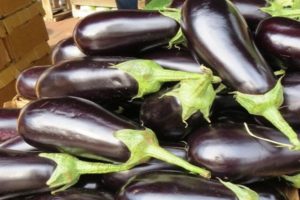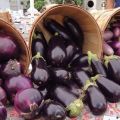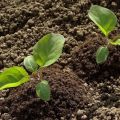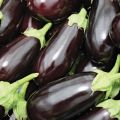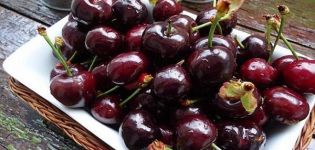What varieties of eggplants are better to plant and grow in the Moscow region in the open field and greenhouses
To facilitate the process of growing crops, producers breed species that are adapted to planting conditions. The summer resident will have to choose from the best varieties of eggplant for the greenhouses of the Moscow region.
Content
- 1 Eggplants for the Moscow region, what are the features and requirements for characteristics
- 2 Open field eggplants
- 3 Eggplant varieties for greenhouses
- 4 Which variety to choose
- 5 How to grow eggplant seedlings for the Moscow region
- 6 Growing eggplants in a greenhouse and open field
- 7 When to harvest
- 8 Errors of inexperienced gardeners
Eggplants for the Moscow region, what are the features and requirements for characteristics
Plants are demanding for heat and light, so planting in the Moscow region at first glance seems impossible. Breeders have bred species that can bear fruit in conditions of temporary drops in temperature and a short, short warm period of summer.
The most important condition for successful crop cultivation is the use of a seedling planting method. Direct seeding into the ground is impractical. For the right choice of varietal assortment, only varieties that ripen early should be considered, mid-ripening is the maximum. In the open ground, the late ones do not have time to mature and will be destroyed by the first autumn frosts.
Open field eggplants
When choosing species for planting on unprotected beds, some signs should be considered:
- The selected species must be immune to temperature extremes.
- The plant should set the fruits regardless of accompanying factors, prolonged rains or lack of sun.
- Select undersized species, it is easier to cover them in case of a cold snap.
- Choose among varieties of short daylight hours.
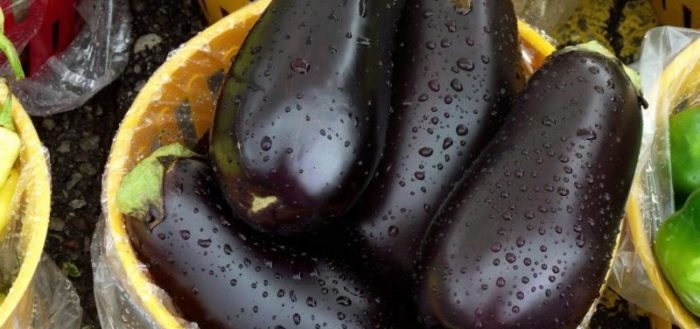
It is better to grow the crop in a seedling way, so the growing season is greatly reduced, and the crop ripens much earlier.
Agate F1
The plant requires regular watering and feeding. Afraid of frost.
Description:
- low bushes;
- ready for use on the 110th day;
- crop volume 6.5-6.9 kg per 1 m2;
- the shade of the eggplant skin is deep purple;
- cylinder shape;
- vegetable mass 250 g;
- the flesh inside is white;
- does not taste bitter;
- are used for momentary use, without any procedures.
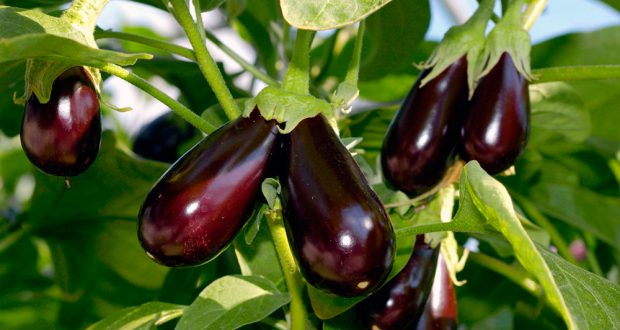
This type of eggplant is difficult to grow and requires careful attention and care.
Albatross
When growing albatross eggplants, there will be no problems with TMV and PTO diseases. The variety is not susceptible to their pathogens. But it requires close attention when carrying out preventive treatments against other diseases.The use of chemicals is desirable only before flowering, then it is recommended to use folk methods of struggle.
Description:
- low bushes grow up to 70 cm;
- ready for use on the 120th day;
- yield 9 kg per 1 m32;
- the shade of the eggplant skin is deep purple;
- pear-shaped;
- vegetable mass 350 g;
- the flesh is greenish inside;
- does not taste bitter.
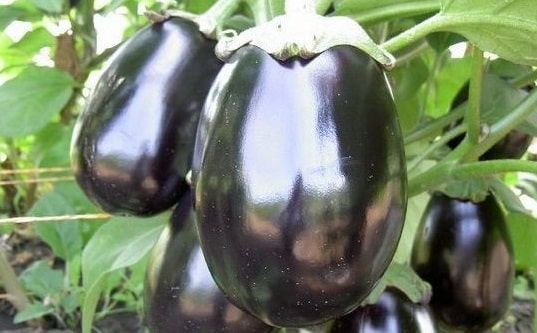
Timely carrying out of the necessary work to care for a growing plant will give a stable, declared yield. The seeds of the variety are harvested on their own, since the Albatross is not a hybrid.
Robin Hood
A good variety for training beginners, does not require special personal care. The harvest is stable, not capricious. The early ripening period allows harvesting from mid-July.
Specifications:
- grows up to 55-60 cm;
- ready for use on the 90th day;
- harvest volume 5.5-6 kg per 1 m2;
- the shade of the eggplant skin is lilac;
- keg shape;
- vegetable weight 300 g, length 20 cm, diameter 8 cm;
- the flesh inside is white;
- does not taste bitter.
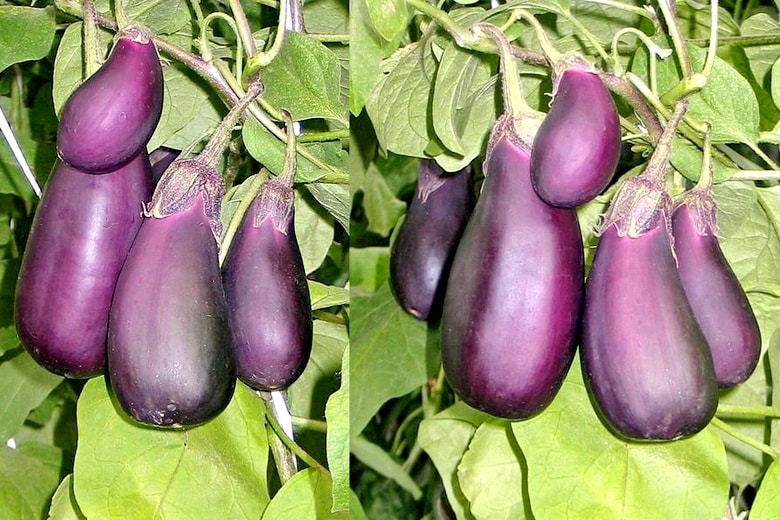
It is used for any method of preparing cold snacks, second courses and winter preparations. In addition, it is appreciated by summer residents for its high resistance to diseases.
Giselle F1
A hybrid adapted to the unstable climate conditions of the Moscow region. The features and positive properties include the ability of plants to tolerate heat and drought.
Specifications:
- grows up to 1.25 m;
- ready for use on the 115th day;
- yield 9 kg per 1 m32;
- the shade of the eggplant skin is dark purple;
- cylinder shape;
- vegetable weight 400 g, length 30 cm, diameter 7 cm;
- the flesh inside is white;
- does not taste bitter.
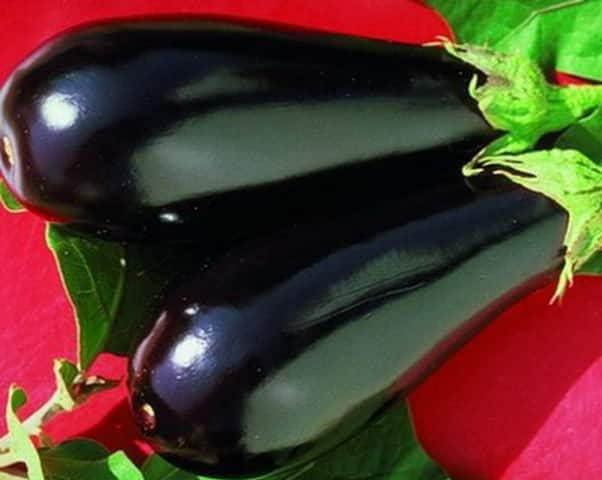
Self-collected planting material does not preserve parental genes. Cut vegetables are stored for 45 days without damage and loss of a presentable appearance. The taste does not change either.
Mirwal F1
Plants of this hybrid have high field health. Excellent taste makes eggplant a favorite for many summer residents.
Description:
- grows up to 1 m;
- ready for use on the 55th day after the plants are taken in the beds;
- harvest volume 5-6 kg per 1 m2;
- eggplant skin tone is almost black;
- elongated shape;
- vegetable weight 400 g, length 22 cm, diameter 10 cm;
- the pulp is light inside;
- does not taste bitter.
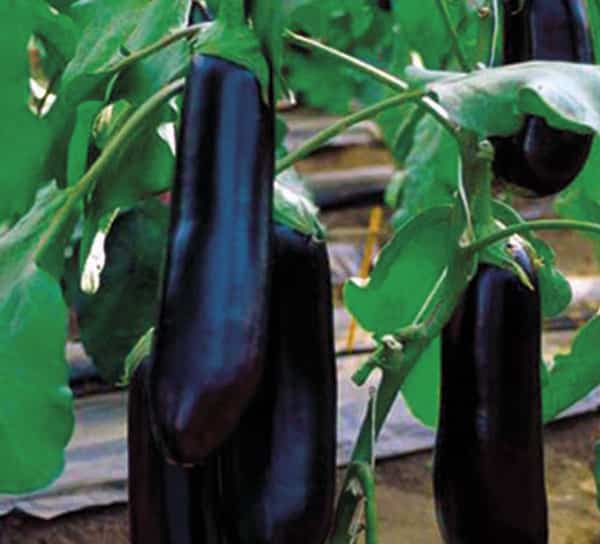
The set is stable, the harvested fruits tolerate transportation well and retain their commercial characteristics for a long time.
King of the north
The species is adapted for distribution in such an area, in which it is rather risky to engage in agriculture. Adapted to difficult weather conditions. It is not afraid of frost, but does not tolerate heat.
Description
- grows up to 60-65 cm;
- ready for use on the 120th day;
- harvest volume 15 kg per 1 m2;
- the shade of the eggplant skin is purple;
- cylinder shape;
- vegetable weight 300 g, length 40 cm, diameter 10 cm;
- the flesh inside is white;
- does not taste bitter.

There are no thorns at all. This makes picking vegetables easier.Planting only in seedlings, it is recommended to mulch the soil. Too long fruits begin to rot after contact with the ground.
Snowy
White-fruited eggplant with excellent productivity. Immune to TMV, a common culture disease.
Characteristic:
- grows up to 90 cm;
- ready for use on the 105th day;
- harvest volume 8 kg per 1 m32;
- eggplant skin color is white;
- oblong shape;
- vegetable weight 350 g, length 20 cm, diameter 6 cm;
- the pulp is light inside;
- does not taste bitter.
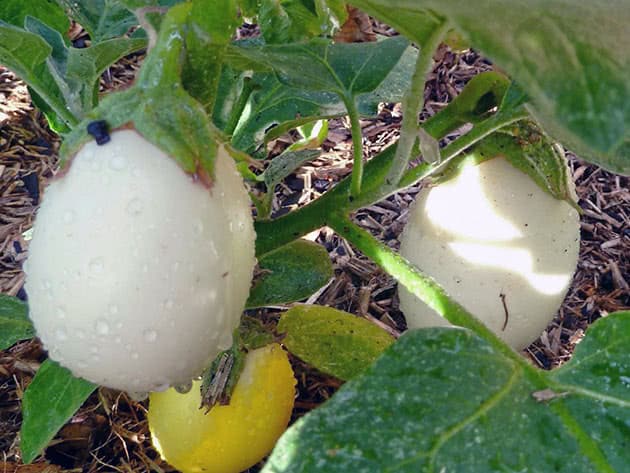
Outwardly unusual fruits will decorate any dish. And pickiness in care will allow you to get healthy and tasty vegetables without much effort.
Mushroom taste
Breeders do not get tired of surprising sophisticated gourmets. They create new varieties that amaze the imagination. Species The taste of mushrooms is special because its pulp tastes like mushrooms.
Description:
- grows up to 80 cm;
- ready for use on the 105th day;
- yield 6.5 kg per 1 m32;
- eggplant skin color is white;
- drop shape;
- vegetable weight 200 g, length 10-15 cm, diameter 4-6 cm;
- the pulp is light inside;
- does not taste bitter.
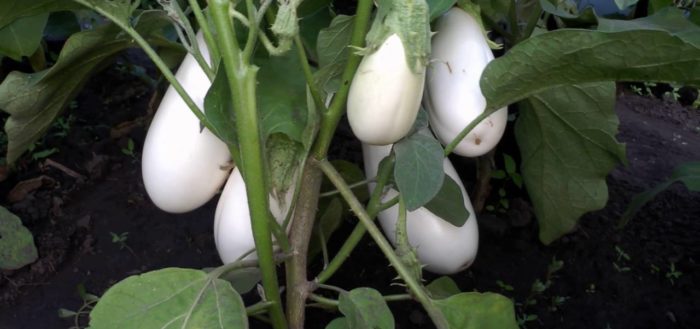
The field of application of the vegetable is extensive, fresh salads, cold snacks, hot dishes and winter preparations are prepared from it.
Eggplant varieties for greenhouses
Planting indoors makes the task a little easier for the summer resident. This is achieved by stabilizing the temperature and a certain humidity. Plants grow at a measured pace, everything develops in a timely manner, ovaries form on time and fruits ripen.
The selection of varieties is also necessary according to some criteria:
- daylight hours;
- cold resistance;
- and other characteristics that are important for an individual family.
Bagheera F1
High immunity to common diseases of the culture makes this hybrid popular among summer residents. Does not require special care.
Characteristic:
- grows up to 1.4 m;
- ready for use on the 115th day;
- crop volume 3 kg per bush;
- the shade of the eggplant skin is purple;
- cylinder shape;
- vegetable weight 250 g, length 20 cm, diameter 5 cm;
- the pulp inside is creamy;
- bitterness is present in the taste.

The Bagheera hybrid does not tolerate lower and higher temperatures, this problem will not be so acute in the greenhouse. Compact bushes take up little space.
Caviar F1
An excellent hybrid, disease resistant and suitable for a variety of dishes with its use. Used for any kitchen table masterpiece.
Description:
- grows up to 80 cm;
- ready for use on the 125th day;
- harvest volume 7 kg per 1 m2;
- the shade of the eggplant skin is dark purple;
- pear-shaped;
- vegetable weight 350 g, length 18 cm, diameter 8 cm;
- the pulp is light inside;
- does not taste bitter and there are no seeds.
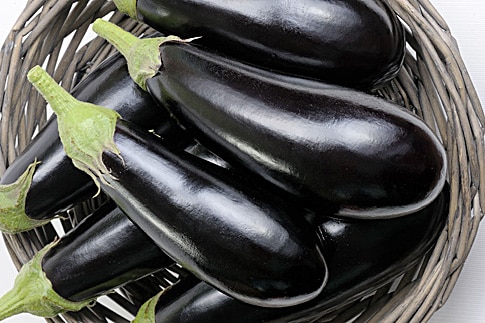
Compliance with planting rules and timely implementation of agrotechnical techniques will help to get a record harvest.
Black Prince
Another excellent work of the producers of new varieties. The cultivated variety of culture is undemanding to the composition of the soil, unpretentious, has the ability to quickly form ovaries.
Characteristic:
- grows up to 60 cm;
- ready for use on the 115th day;
- harvest volume 8 kg per 1 m32;
- the shade of the eggplant skin is deep purple;
- curved cylinder shape;
- vegetable weight 350 g, length 20 cm, diameter 7 cm;
- the flesh is greenish inside;
- does not taste bitter.
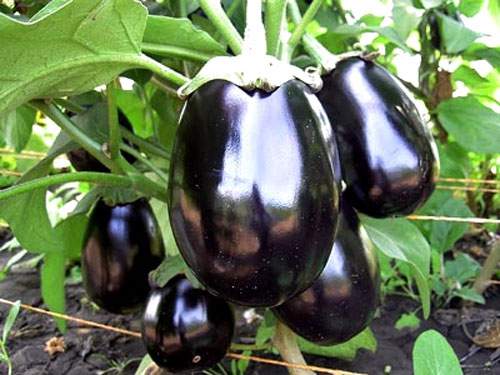
There are no thorns, which greatly simplifies the work of picking vegetables. The harvest type of the Black Prince culture allows you to collect your own planting material.
Donetsk fruitful
This early maturing variety is relatively resistant to fusarium wilt. Undemanding in care, is rapidly gaining recognition among summer residents.
Description:
- grows up to 50 cm;
- ready for use on the 130th day;
- harvest volume 5.5 kg per 1 m2;
- the shade of the eggplant skin is purple;
- oblong shape;
- vegetable weight 130 g, length 20 cm, diameter 7 cm;
- the pulp is light inside;
- does not taste bitter.
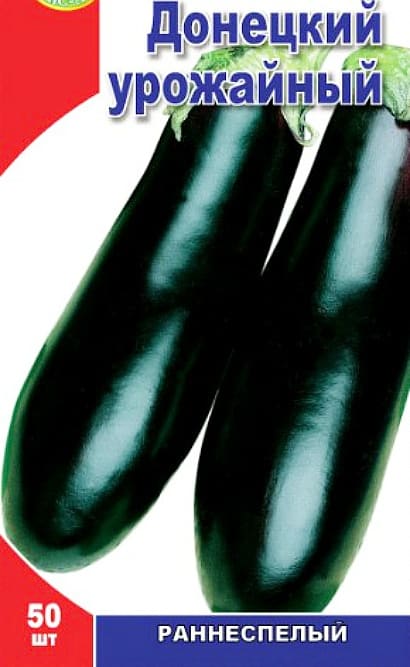
To grow eggplant varieties Donetsk fruitful, you will not have to face any difficulties. You don't need to do anything special, only standard agrotechnical techniques are performed.
hippopotamus
High yielding hybrid suitable for greenhouse cultivation. The plant has thorns; harvest should be done with caution.
Characteristic:
- grows up to 1.5 m;
- ready for use on the 115th day;
- harvest volume 17.5 kg per 1 m32;
- the shade of the eggplant skin is dark purple;
- pear-shaped;
- vegetable weight 350 g, length 18 cm, diameter 8 cm;
- the pulp is beige inside;
- does not taste bitter.
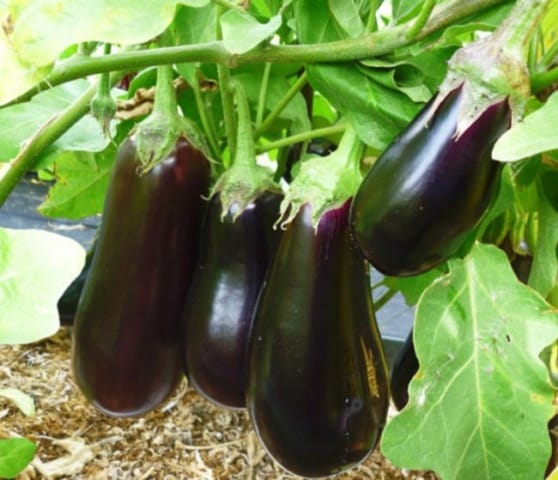
Observing all the requirements for care and cultivation, 5-6 kg of vegetables are harvested from 1 bush.
Lolita
It is a high-yielding species, recommended for planting in greenhouses, as it categorically does not tolerate wind and cold snaps. With proper care, it produces record yields. A feature of the variety is the ability to grow in any soil composition.
Description:
- grows up to 2.7 m;
- ready for use on the 110th day;
- harvest volume 5 kg per 1 m2;
- the shade of the eggplant skin is purple;
- oblong shape;
- vegetable weight 300 g, length 25 cm, diameter 7 cm;
- the pulp inside is creamy;
- does not taste bitter.
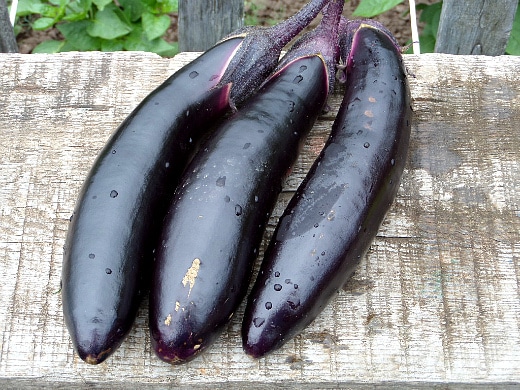
Lolita's yield depends on the climatic characteristics of the growing region and the correct implementation of agrotechnical methods of care.
Baikal F1
The vegetable ripens early enough, in addition, it has high immunity. Therefore, preventive treatment is not required. The plant is so unpretentious that caring for it consists in timely watering and feeding.
Specifications:
- grows up to 1.2 m;
- ready for use on the 110th day;
- harvest volume 8 kg per 1 m32;
- the shade of the eggplant skin is dark purple;
- pear-shaped;
- vegetable weight 300 g, length 20 cm, diameter 6 cm;
- the flesh inside is white;
- does not taste bitter.
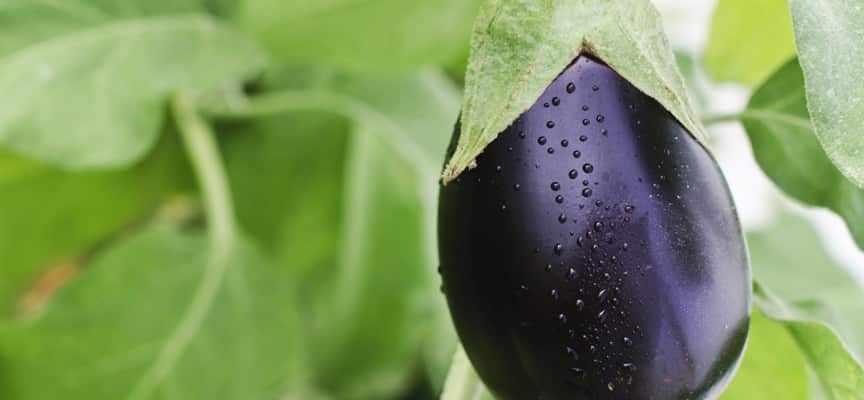
Garter to the supports is recommended. The plant itself is not able to withstand the large weight of the fruit. Vegetables are suitable for any preparation method; cooking hot dishes and snacks is dictated by the fact that the fruits do not taste bitter and have an excellent taste.
Fat gentleman
The uniqueness of its appearance makes the variety popular among lovers of unusual vegetables. The fruits are tied under the condition of temperature drop.
Description:
- grows up to 1 m;
- ready for use on the 120th day;
- harvest volume 8 kg per 1 m32;
- the shade of the eggplant skin is deep purple;
- ball shape;
- vegetable weight 200 g, length 16 cm, diameter 12 cm;
- the pulp inside is light, dense;
- does not taste bitter.
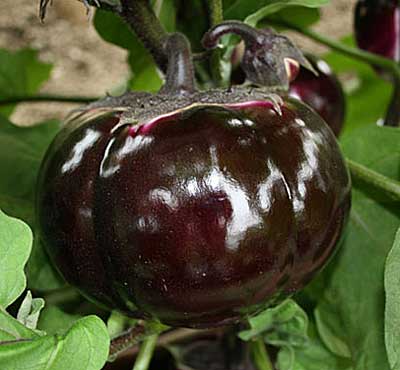
Plants are unpretentious, but require a mandatory garter to the supports.
Vikar
The plant calmly tolerates minor cold snaps, the ovaries do not crumble, and the plant continues to set new ones. He does not have any special care features, it is enough to take into account the advice of experienced summer residents, actively applying them in practice.
Characteristic:
- grows up to 1 m;
- ready for use on the 115th day;
- harvest volume 4.8 kg per 1 m2;
- eggplant skin tone is light purple;
- pear-shaped;
- vegetable weight 150 g, length 20 cm, diameter 7 cm;
- the pulp inside is light green;
- does not taste bitter.
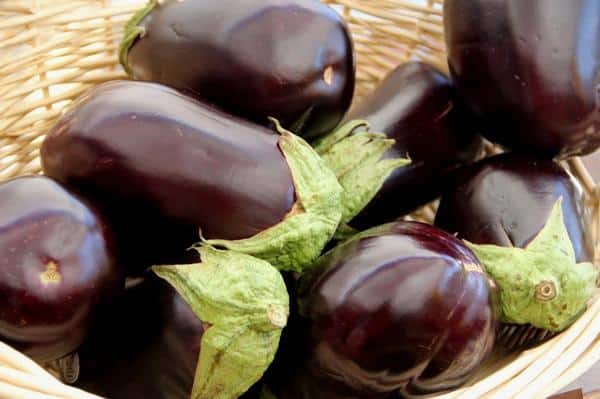
It is widely used in the preparation of various dishes. The use of vegetables in cooking depends on the imagination and skills of the housewife. There are few thorns on the bushes, it is advisable to observe precautions when harvesting.
Alenka
Recommended for cultivation in greenhouses; under other planting conditions, the fruits become smaller. The original color makes the variety popular among lovers of unusual vegetables.
Description:
- grows up to 70 cm;
- ready for use on the 105th day;
- harvest volume 7 kg per 1 m2;
- eggplant skin tone is greenish;
- cylinder shape;
- vegetable weight 350 g, length 15 cm, diameter 6 cm;
- the pulp inside is light green, dense;
- does not taste bitter.
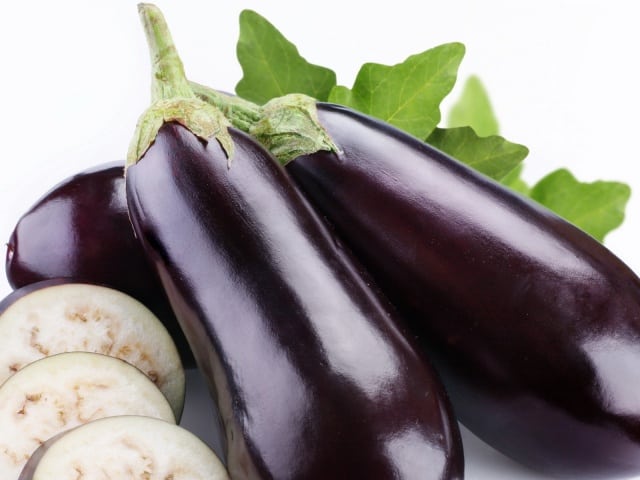
A garter and the formation of plants of the Alenka species are required, but otherwise the care does not differ from other vegetable crops. Regular watering stimulates high fruit set.
Northern blues
Bushes form ovaries in conditions of temporary temperature changes. Vegetables of excellent taste, tender and dense.
Specifications:
- grows up to 1.7 m;
- ready for use on the 105th day;
- yield 4.5 kg per 1 m2;
- eggplant skin tone is dark lilac;
- pear-shaped;
- vegetable weight 250 g, length 13 cm, diameter 6 cm;
- the pulp is beige inside, medium-dense;
- does not taste bitter.
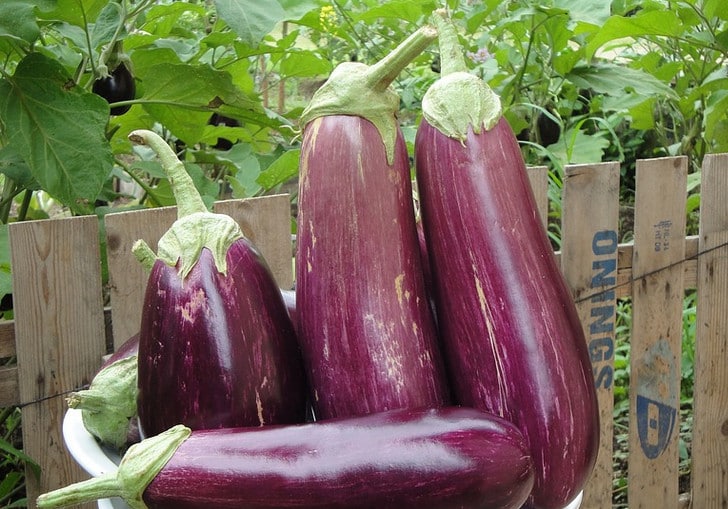
The high yield and unpretentiousness add more and more admirers of this variety.
Which variety to choose
The correct choice depends on how the crop will be grown. For the greenhouse and open ground, choose early and middle varieties. It is best not to plant late varieties, as their cultivation is impractical. The first autumn frosts will beat the entire crop, preventing it from reaching technical maturity.
The main signs, the presence of which is required:
- resistance to low temperatures;
- short growing season.
The rest of the properties of the varieties are selected at the request of the summer resident. Breeders develop special early ripening varieties, the growing season of which is 85-90 days:
- Early dwarf.
- King of the North and other varieties.

If you choose among hybrids, then in addition to the listed characteristics, yield, unpretentiousness, high immunity and other important characteristics are added.
How to grow eggplant seedlings for the Moscow region
This is a difficult process, but if you delve into all the subtleties, then planting seeds for seedlings will not cause difficulties. Ready-made plants are purchased from the hands. But it's best to grow the seedlings yourself.
First of all, the soil and planting material are prepared. The land must be fertile, the composition is as follows:
- 1 part of sod land;
- 1 part river sand with silt;
- 2 parts of humus.
Everything is thoroughly mixed, the finished mixture is filled in containers in which the seedlings will be grown. Eggplants have a root system that is easily injured. Due to damage to the roots, the plants will hurt or completely dry out.
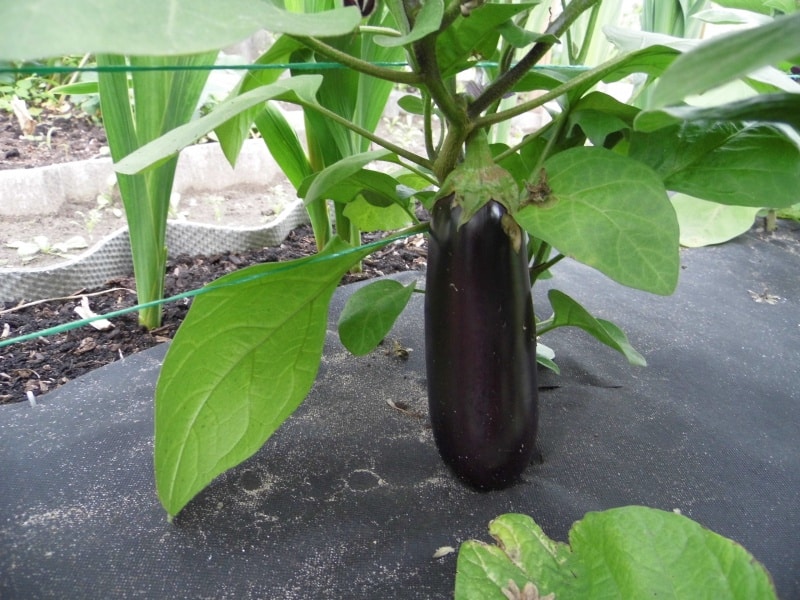
It is recommended to sow the planting material directly into the container. Take disposable or use peat pots. Then the plant practically does not experience stress after being transferred to a permanent place. Seeds are checked for germination before sowing. To do this, take a small part and wrap it in cheesecloth.
Keep it constantly moist, after 4-5 days, check the number of germinated plants. If less than 50%, sowing such seeds is impractical, if more, then the planting material is suitable for sowing.
The timing of planting seeds for seedlings is the second decade of February - the first decade of March. The seeding depth is 1-2 cm, then the containers are covered with glass or tightened with polyethylene. They are placed in a dark, warm place for germination. After emergence, they are placed in the sun and the soil is constantly kept moist. At first, a spray bottle is used for watering. With a lack of sunlight, additional lighting is organized. Only 12-14 hours a day. For plants with short daylight hours, arrange additional lighting for no longer than 12 hours a day. For support, watered with growth stimulants or complex fertilizers 1-2 times.
Growing eggplants in a greenhouse and open field
At first glance, growing a culture seems difficult. In fact, there shouldn't be any problems. And this applies not only to beginners, but also to experienced vegetable growers.
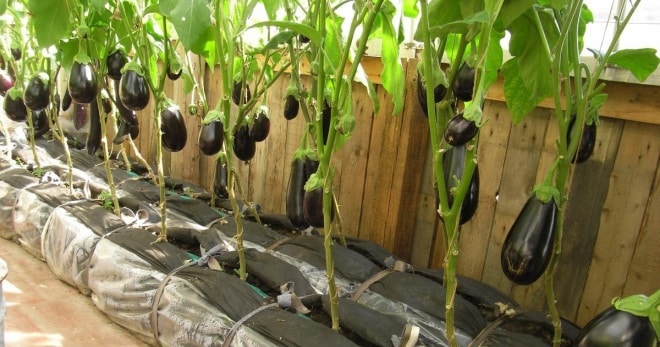
Seedlings are planted in the greenhouse in the second decade of May. It should be planted in open ground in late May - early June. Despite the fact that the culture develops and grows better in the greenhouse, not all summer residents have the opportunity to buy or install it on the site.
But eggplants also grow in the fresh air, over them they construct arcs with polyethylene stretched over them. Thus, they protect against drafts and night drops in temperature. When growing crops in a greenhouse, the soil is prepared in advance, it is advisable to do this in the fall. The soil is enriched with mineral fertilizers, humus and wood ash.
When to harvest
It all depends on the cultivated variety. Different periods of ripening, size and color of the vegetable make it difficult to give a clear definition of a ripe fruit. Early varieties are picked 2-3 weeks after the flowers appear. But these fruits are not very tasty. The variety has excellent taste characteristics only at the stage of technical maturity.
The fruits are plucked every 5 days, this will provoke the appearance of new ovaries on the bushes. The richer the glossy shine, the riper the vegetables.
Harvesting is dictated by a specific purpose. If a vegetable is needed for preparing a dish or preparations for the winter, technically ripe specimens are used. If collection of planting material is required, then biological maturity is awaited.
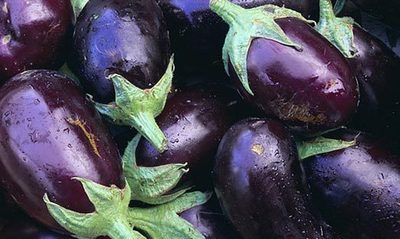
It is difficult to answer unequivocally how to determine the technical maturity of the fruit, since different varieties ripen in different ways. It is important to be guided by the term given by the manufacturer.And then in the event that the plants did not hurt and did not stop growing for a while. First of all, the lowest fruits ripen, then, gradually moving up, the rest ripen. The harvested crop is stored for several months, again depending on the type of crop.
Store carefully selected specimens in boxes of straw or parchment paper. Install them in a dark, cool room with a constant temperature.
Errors of inexperienced gardeners
Mistakes are made not only by beginners, but also by those summer residents who have been growing crops on the site for years. Anyone can make mistakes in work:
- Planting seedlings in the ground. When I wanted to, then they transplanted. This is wrong, a 60-day seedling will yield a full harvest. Its quantity will be as close as possible to the declared indicators.
- Violation of the root system. Diving or transplanting into containers, from which the plants are then pulled out, lead to root damage. After that, the transplanted seedling is sick for a long time and begins to lag behind in growth.
- Unwanted neighborhood. Growing in beds next to tomatoes and potatoes. Plants oppress each other and generously share diseases and pests.
- Improper loosening. While providing oxygen to the root system, it is important not to overdo it. If the soil is loosened too deeply, the delicate roots are damaged. The plant stops growing and starts to hurt. The death of the bush is possible.
- Correct formation. Removal of excess shoots leads to the fact that the remaining fruits receive more nutrition. As a result, tasty, large eggplants grow.
Planting culture in the suburbs is not difficult. You need to get a greenhouse or build it yourself. Plant seeds on seedlings and, following standard techniques, take good care of the eggplant. In return, the plants will give the full harvest declared by the producers.

